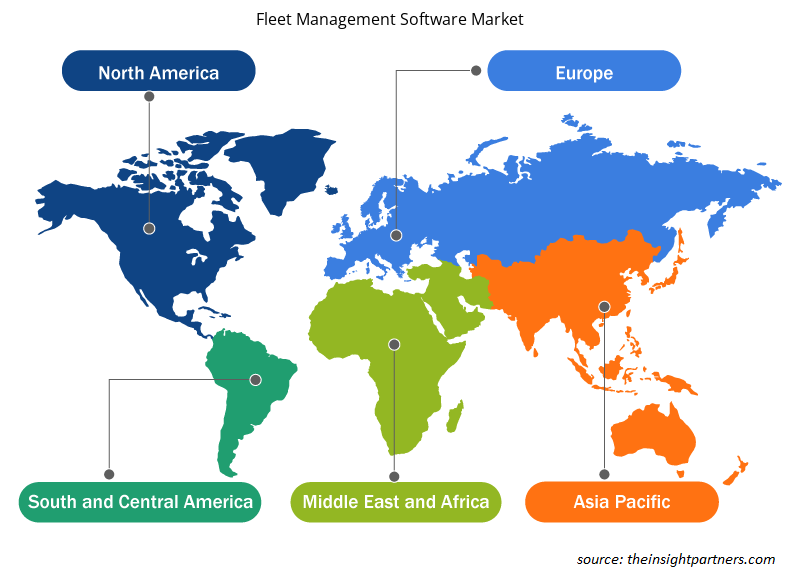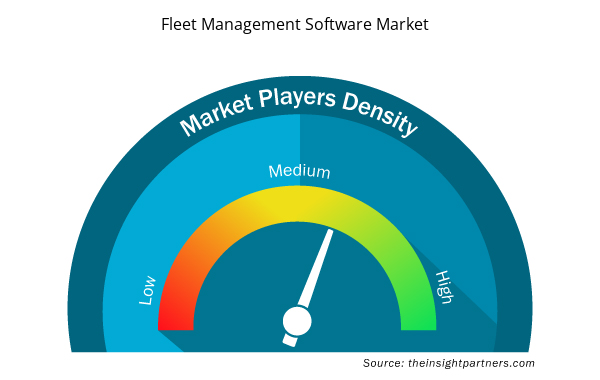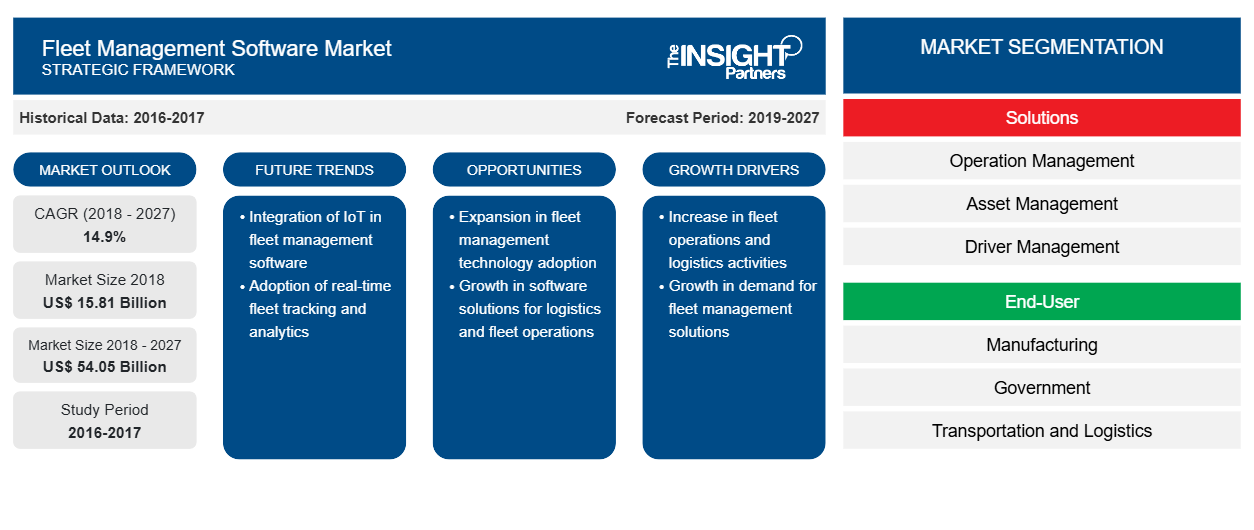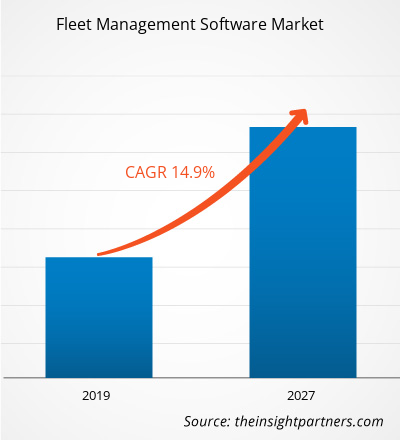Der globale Markt für Flottenmanagement-Software soll von 15,81 Milliarden US-Dollar im Jahr 2018 auf 54,05 Milliarden US-Dollar im Jahr 2027 wachsen. Dies entspricht einer durchschnittlichen jährlichen Wachstumsrate von 14,9 % im Zeitraum von 2019 bis 2027.
Europa war der führende geografische Markt und wird voraussichtlich im gesamten Prognosezeitraum den höchsten Umsatzbeitrag leisten. Aufgrund der steigenden Ausgaben im Automobilsektor der Region wird erwartet, dass der europäische Markt für Flottenmanagementsoftware in den kommenden Jahren bis 2027 schrittweise wachsen wird.
Markteinblicke
Nutzung drahtloser Technologien für den Flottenbetrieb dürfte den Markt ankurbeln
Derzeit wächst die Wireless-Branche enorm und verzeichnet neue Rekorde in Bezug auf Netzwerkverkehr, Netzwerkinfrastruktur und Bereitstellung von Wireless-Verbindungen. Durch die weltweite Einführung des Internets der Dinge (IoT) können verschiedene Systeme, die in verschiedenen Branchen eingesetzt werden, durch Wireless-Technologien verbessert werden. Wireless-Technologien spielen eine wichtige Rolle bei der Förderung der Wirtschaft verschiedener Länder auf der ganzen Welt. Mehrere potenzielle Länder auf der ganzen Welt tragen zur Wirtschaft des Landes bei, um auf dem Markt wettbewerbsfähig zu bleiben. Laut CTIA, einem Branchenverband für die Wireless-Kommunikationsbranche mit Sitz in den USA, trug die Wireless-Branche beispielsweise im Jahr 2016 jährlich 475 Milliarden US-Dollar zur US-Wirtschaft bei.
Verschiedene Unternehmen verwenden Flottenmanagementsoftware, um die Flottenfahrzeuge zu steuern. Die Integration von drahtlosen Technologien in die Flottenmanagementsoftware erhöht die Effizienz der Flotten und trägt dazu bei, die Belastung der Flottenbetreiber zu verringern. Drahtlose Technologien wie GPS- und Fahrzeugortungssysteme helfen dabei, außergewöhnliche Einblicke in die Leistung der Flotte zu gewinnen. Diese drahtlosen Technologien verbessern auch das Verhalten des Fahrers, indem sie die Geschwindigkeit des Fahrzeugs, starkes Bremsen und vieles mehr überwachen. Darüber hinaus werden laut einer Studie rund 13 Millionen Geräte mit drahtloser Konnektivität eingesetzt, um Flottenfahrzeuge zu verwalten, und diese Zahl könnte im Prognosezeitraum noch steigen. Da die zunehmende Betonung drahtloser Technologien im Fahrzeugbetrieb den Anbietern hilft, ihre Produktivität und Effizienz zu steigern, wird der globale Markt für Flottenmanagementsoftware im Prognosezeitraum angekurbelt.
Passen Sie diesen Bericht Ihren Anforderungen an
Sie erhalten kostenlos individuelle Anpassungen an jedem Bericht, einschließlich Teilen dieses Berichts oder einer Analyse auf Länderebene, eines Excel-Datenpakets sowie tolle Angebote und Rabatte für Start-ups und Universitäten.
- Holen Sie sich die wichtigsten Markttrends aus diesem Bericht.Dieses KOSTENLOSE Beispiel umfasst eine Datenanalyse von Markttrends bis hin zu Schätzungen und Prognosen.
Globaler Markt für Flottenmanagementsoftware – Lösungseinblicke
Der globale Markt für Flottenmanagementsoftware wurde nach Lösungen vom Segment Betriebsmanagement angeführt. Das Segment Fahrzeugwartung und -leasing hatte 2018 den zweitgrößten Markt und dürfte seine Anteile im Prognosezeitraum von 2019 bis 2027 ausbauen.
Globaler Markt für Flottenmanagementsoftware – Einblicke für Endbenutzer
Der globale Markt für Flottenmanagementsoftware nach Endnutzern wurde vom Transport- und Logistiksegment angeführt. Das Fertigungssegment hielt 2018 den zweitgrößten Markt und dürfte seine Anteile im Prognosezeitraum von 2019 bis 2027 ausbauen.
Die Marktteilnehmer auf dem Markt für Flottenmanagementsoftware konzentrieren sich hauptsächlich auf Produktverbesserungen durch die Implementierung fortschrittlicher Technologien. Durch den Abschluss von Partnerschaften, Verträgen, Joint Ventures, Finanzierungen und die Eröffnung neuer Niederlassungen auf der ganzen Welt kann das Unternehmen seinen Markennamen weltweit aufrechterhalten. Einige der jüngsten Entwicklungen sind unten aufgeführt:
2019: Im April 2019 gab Geotab, Inc. eine Vereinbarung zur Übernahme von BSM Technologies bekannt, einem Anbieter von Telematik- und Asset-Management-Lösungen. Durch die Implementierung der Geotab-Lösung erhalten BSM-Kunden in der Regierung sowie in Branchen wie Bauwesen, Dienstleistung und Bahn Zugang zu verbesserter Transparenz in Bezug auf Fahrgewohnheiten, Fahrzeugleistung, Unfallerkennung und mehr.
2019: Im März 2019 übernahm Omnitracs, LLC das Softwareunternehmen Blue Dot Solutions. Omnitracs, LLC würde die MilesAhead-Produktsuite von Blue Dot integrieren, die der Branche eine Lösung mit höchster Fähigkeit zur Verbesserung der Produktivität, Flexibilität, Skalierbarkeit und Sicherheit des gesamten Flottenbetriebs bieten würde.
2018: Im Juni 2018 übernahm Geotab Inc. FleetCarma, das auf Telematik für Elektrofahrzeuge (EV) spezialisiert ist. Die Übernahme von FleetCarma würde es seinem Kunden ermöglichen, eine vollständige Flottenmanagementlösung bereitzustellen.
Regionale Einblicke in den Markt für Flottenmanagementsoftware
Die regionalen Trends und Faktoren, die den Markt für Flottenmanagement-Software im Prognosezeitraum beeinflussen, wurden von den Analysten von Insight Partners ausführlich erläutert. In diesem Abschnitt werden auch die Marktsegmente und die Geografie von Flottenmanagement-Software in Nordamerika, Europa, im asiatisch-pazifischen Raum, im Nahen Osten und Afrika sowie in Süd- und Mittelamerika erörtert.

- Erhalten Sie regionale Daten zum Markt für Flottenmanagement-Software
Umfang des Marktberichts zur Flottenmanagementsoftware
| Berichtsattribut | Details |
|---|---|
| Marktgröße im Jahr 2018 | 15,81 Milliarden US-Dollar |
| Marktgröße bis 2027 | 54,05 Milliarden US-Dollar |
| Globale CAGR (2018 - 2027) | 14,9 % |
| Historische Daten | 2016-2017 |
| Prognosezeitraum | 2019–2027 |
| Abgedeckte Segmente | Nach Lösungen
|
| Abgedeckte Regionen und Länder | Nordamerika
|
| Marktführer und wichtige Unternehmensprofile |
|
Dichte der Marktteilnehmer für Flottenmanagement-Software: Die Auswirkungen auf die Geschäftsdynamik verstehen
Der Markt für Flottenmanagementsoftware wächst rasant, angetrieben durch die steigende Nachfrage der Endnutzer aufgrund von Faktoren wie sich entwickelnden Verbraucherpräferenzen, technologischen Fortschritten und einem größeren Bewusstsein für die Vorteile des Produkts. Mit steigender Nachfrage erweitern Unternehmen ihr Angebot, entwickeln Innovationen, um die Bedürfnisse der Verbraucher zu erfüllen, und nutzen neue Trends, was das Marktwachstum weiter ankurbelt.
Die Marktteilnehmerdichte bezieht sich auf die Verteilung der Firmen oder Unternehmen, die in einem bestimmten Markt oder einer bestimmten Branche tätig sind. Sie gibt an, wie viele Wettbewerber (Marktteilnehmer) in einem bestimmten Marktraum im Verhältnis zu seiner Größe oder seinem gesamten Marktwert präsent sind.
Die wichtigsten auf dem Markt für Flottenmanagementsoftware tätigen Unternehmen sind:
- ARI Flottenmanagement-Unternehmen
- Element Fleet Management Corp.
- Geotab Inc.
- GPS-Einblick
- NexTraq, LLC
Haftungsausschluss : Die oben aufgeführten Unternehmen sind nicht in einer bestimmten Reihenfolge aufgeführt.

- Überblick über die wichtigsten Akteure auf dem Markt für Flottenmanagementsoftware
GLOBALER MARKT FÜR FLOTTENMANAGEMENT-SOFTWARE – MARKTSEGMENTIERUNG
Globaler Markt für Flottenmanagementsoftware nach Lösungen
- Betriebsmanagement
- Vermögensverwaltung
- Fahrermanagement
- Fahrzeugwartung & Leasing
- Fahrerinformationssystem
- Sonstiges
Globaler Markt für Flottenmanagementsoftware nach Endbenutzer
- Herstellung
- Regierung
- Transport und Logistik
- Energie und Versorgung
- Einzelhandel
- Konstruktion
- Sonstiges
Globaler Markt für Flottenmanagementsoftware nach Regionen
- Nordamerika
- Europa
- Asien-Pazifik
- Naher Osten und Afrika
- Südamerika
Globaler Markt für Flottenmanagementsoftware – Erwähnte Unternehmen
- ARI Flottenmanagement-Unternehmen
- Element Fleet Management Corp.
- Geotab Inc.
- GPS-Einblick
- NexTraq, LLC
- Omnitracs, LLC
- Teletrac Navman US Ltd
- Trimble, Inc.
- Verizon Connect
- Räder, Inc.
- Historische Analyse (2 Jahre), Basisjahr, Prognose (7 Jahre) mit CAGR
- PEST- und SWOT-Analyse
- Marktgröße Wert/Volumen – Global, Regional, Land
- Branche und Wettbewerbsumfeld
- Excel-Datensatz



Report Coverage
Revenue forecast, Company Analysis, Industry landscape, Growth factors, and Trends

Segment Covered
This text is related
to segments covered.

Regional Scope
North America, Europe, Asia Pacific, Middle East & Africa, South & Central America

Country Scope
This text is related
to country scope.
Trends and growth analysis reports related to Technology, Media and Telecommunications : READ MORE..
The List of Companies
- ARI Fleet Management Company
- Element Fleet Management Corp.
- Geotab Inc.
- GPS Insight
- NexTraq, LLC
- Omnitracs, LLC
- Teletrac Navman US Ltd
- Trimble, Inc.
- Verizon Connect
- Wheels, Inc.
The Insight Partners performs research in 4 major stages: Data Collection & Secondary Research, Primary Research, Data Analysis and Data Triangulation & Final Review.
- Data Collection and Secondary Research:
As a market research and consulting firm operating from a decade, we have published and advised several client across the globe. First step for any study will start with an assessment of currently available data and insights from existing reports. Further, historical and current market information is collected from Investor Presentations, Annual Reports, SEC Filings, etc., and other information related to company’s performance and market positioning are gathered from Paid Databases (Factiva, Hoovers, and Reuters) and various other publications available in public domain.
Several associations trade associates, technical forums, institutes, societies and organization are accessed to gain technical as well as market related insights through their publications such as research papers, blogs and press releases related to the studies are referred to get cues about the market. Further, white papers, journals, magazines, and other news articles published in last 3 years are scrutinized and analyzed to understand the current market trends.
- Primary Research:
The primarily interview analysis comprise of data obtained from industry participants interview and answers to survey questions gathered by in-house primary team.
For primary research, interviews are conducted with industry experts/CEOs/Marketing Managers/VPs/Subject Matter Experts from both demand and supply side to get a 360-degree view of the market. The primary team conducts several interviews based on the complexity of the markets to understand the various market trends and dynamics which makes research more credible and precise.
A typical research interview fulfils the following functions:
- Provides first-hand information on the market size, market trends, growth trends, competitive landscape, and outlook
- Validates and strengthens in-house secondary research findings
- Develops the analysis team’s expertise and market understanding
Primary research involves email interactions and telephone interviews for each market, category, segment, and sub-segment across geographies. The participants who typically take part in such a process include, but are not limited to:
- Industry participants: VPs, business development managers, market intelligence managers and national sales managers
- Outside experts: Valuation experts, research analysts and key opinion leaders specializing in the electronics and semiconductor industry.
Below is the breakup of our primary respondents by company, designation, and region:

Once we receive the confirmation from primary research sources or primary respondents, we finalize the base year market estimation and forecast the data as per the macroeconomic and microeconomic factors assessed during data collection.
- Data Analysis:
Once data is validated through both secondary as well as primary respondents, we finalize the market estimations by hypothesis formulation and factor analysis at regional and country level.
- Macro-Economic Factor Analysis:
We analyse macroeconomic indicators such the gross domestic product (GDP), increase in the demand for goods and services across industries, technological advancement, regional economic growth, governmental policies, the influence of COVID-19, PEST analysis, and other aspects. This analysis aids in setting benchmarks for various nations/regions and approximating market splits. Additionally, the general trend of the aforementioned components aid in determining the market's development possibilities.
- Country Level Data:
Various factors that are especially aligned to the country are taken into account to determine the market size for a certain area and country, including the presence of vendors, such as headquarters and offices, the country's GDP, demand patterns, and industry growth. To comprehend the market dynamics for the nation, a number of growth variables, inhibitors, application areas, and current market trends are researched. The aforementioned elements aid in determining the country's overall market's growth potential.
- Company Profile:
The “Table of Contents” is formulated by listing and analyzing more than 25 - 30 companies operating in the market ecosystem across geographies. However, we profile only 10 companies as a standard practice in our syndicate reports. These 10 companies comprise leading, emerging, and regional players. Nonetheless, our analysis is not restricted to the 10 listed companies, we also analyze other companies present in the market to develop a holistic view and understand the prevailing trends. The “Company Profiles” section in the report covers key facts, business description, products & services, financial information, SWOT analysis, and key developments. The financial information presented is extracted from the annual reports and official documents of the publicly listed companies. Upon collecting the information for the sections of respective companies, we verify them via various primary sources and then compile the data in respective company profiles. The company level information helps us in deriving the base number as well as in forecasting the market size.
- Developing Base Number:
Aggregation of sales statistics (2020-2022) and macro-economic factor, and other secondary and primary research insights are utilized to arrive at base number and related market shares for 2022. The data gaps are identified in this step and relevant market data is analyzed, collected from paid primary interviews or databases. On finalizing the base year market size, forecasts are developed on the basis of macro-economic, industry and market growth factors and company level analysis.
- Data Triangulation and Final Review:
The market findings and base year market size calculations are validated from supply as well as demand side. Demand side validations are based on macro-economic factor analysis and benchmarks for respective regions and countries. In case of supply side validations, revenues of major companies are estimated (in case not available) based on industry benchmark, approximate number of employees, product portfolio, and primary interviews revenues are gathered. Further revenue from target product/service segment is assessed to avoid overshooting of market statistics. In case of heavy deviations between supply and demand side values, all thes steps are repeated to achieve synchronization.
We follow an iterative model, wherein we share our research findings with Subject Matter Experts (SME’s) and Key Opinion Leaders (KOLs) until consensus view of the market is not formulated – this model negates any drastic deviation in the opinions of experts. Only validated and universally acceptable research findings are quoted in our reports.
We have important check points that we use to validate our research findings – which we call – data triangulation, where we validate the information, we generate from secondary sources with primary interviews and then we re-validate with our internal data bases and Subject matter experts. This comprehensive model enables us to deliver high quality, reliable data in shortest possible time.


 Holen Sie sich ein kostenloses Muster für diesen Bericht
Holen Sie sich ein kostenloses Muster für diesen Bericht